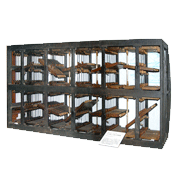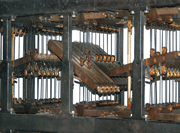Published on Jul. 15, 2011
Last updated on Nov. 6, 2024
Sasaki Tatudiro, Shiga Makoto, and others from Tokyo Imperial University’s Aeronautical Research Institute built the nine simultaneous equation solver, one of Japan’s early large-scale mechanical calculator. The nine simultaneous equation solver was developed based on mechanical calculator for solving simultaneous equations created by MIT professor John Wilbur. The building of the solver is presumed to have been completed in 1944 or 1945, however, no documents have been found.
Wilbur had participated in Vannevar Bush’s computing project at MIT in 1934 and taking the idea of using a machine to solve algebraic equations, he completed his mechanical calculator in 1936. This large, analog computer could solve up to nine simultaneous equations to within one percent accuracy by varying the length of belts by changing the angle of brass bars. The computer was enormously useful in civil engineering structural analysis and calculating matrices for economics.
The Aeronautical Research Institute’s machine had the same construction as Wilbur’s simultaneous calculator and could also solve nine-dimensional simultaneous equations. A nine-dimensional simultaneous equation is generally a set of nine linear equations with one known value and nine unknown values. The nine simultaneous equation solver had brass bars with variable angles attached to steel pulleys. The angle represented an unknown value, and the length of the steel tape attached to the bar’s pulley represented an equation. By moving the bar and reading the tape’s length, the solution to equations could be found.
The nine simultaneous equation solver is on permanent exhibit at the National Museum of Science and Nature. The machine is almost an exact replica of Wilbur’s original calculator, and although several machines of the same type were built around the world, Japan’s is the only extant machine.



